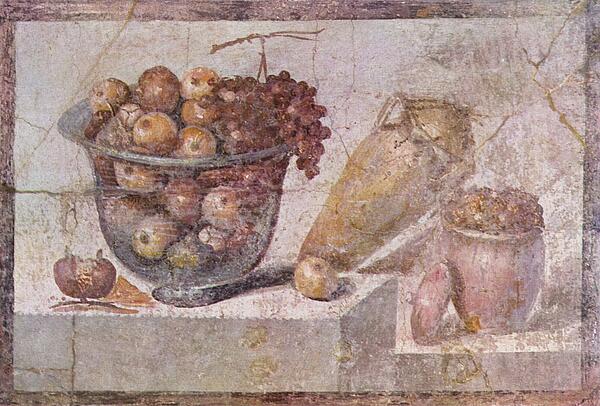Roman Food
Depending on whether you were rich, poor or a soldier in Ancient Rome, you would eat a standard or lavish daily diet.
For the Roman elite, food was a way of demonstrating wealth. Elaborate banquets were a good way of showing off their social status to others, so they included expensive foods such as peacock, ostriches and lots of wine. For a wealthy person’s banquet they served anything that was exotic, and also a lot of sauce dishes to make meals seem more exciting. One of their favourites was ‘garum’ - made by mixing fish waste with salt water and leaving it for weeks to ferment. It naturally turned out to be very salty with a lot of flavour. The Romans also enjoyed sauces made from vinegar, honey, pepper, herbs, and spices. They also loved to have sweet foods and drinks - one in particular called mulsum was a mixture of boiled wine and honey.
It was an accepted part of ancient Roman daily life that when invited to dinner, guests would take along their own personal over-sized napkin. As well as being used to wipe hands and mouths, guests would be encouraged by the host to use it to take home leftovers of the dishes they had enjoyed as a sign that his meal had been well received.

One favourite food of the upper classes was dormice. The mice were raised either in large pits or in terracotta containers and fattened up with walnuts, chestnuts and acorns. The dormice were served by either roasting them and dipping them in honey or stuffing them with pork, pine nuts and other flavours.
Poor people would certainly not have dined on luxury food but had simple stews and broths which they added vegetables and herbs to. Some locals who lived in town apartments did not have their own cooking equipment, so they would have eaten ancient Rome fast food such as kebabs at taverns and snack bars.
Roman soldiers had healthy, high energy food such as bread which was their staple. It is suggested that each Century would have baked their own bread in the large beehive bread ovens placed around the Legionary Fortress at Caerleon. It appears that the soldiers also ate a lot of bacon - every group of eight soldiers had a frying pan kept in their pack. They also consumed porridge and stews which would have included meat and vegetables.
Overall, most food was boiled or fried in olive oil and hardly any homes used an oven as almost no food was roasted.
The Romans lifestyle meant their eating habits were different from today - breakfast was known as jentaculum and taken in the master’s bedroom, where it consisted of a slice of bread or wheat pancake with dates and honey, along with wine to drink. Lunch (or prandium) was eaten earlier, around 11.00am - this was a light meal of bread, cheese and maybe meat. The main meal was called cena and eaten in the late afternoon or early evening. Depending on whether a house had guests, the preparation would be anything between one - four hours. The Romans then had a light supper before bed which was normally bread and fruit. They did not eat a lot of meat and most of their everyday meals included vegetables, herbs and spices with a wheat dish similar to porridge.
See also: Romulus and Remus
MLA Citation/Reference
"Roman Food". HistoryLearning.com. 2024. Web.
